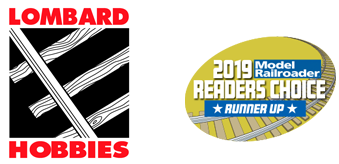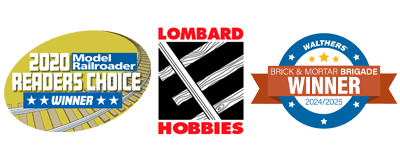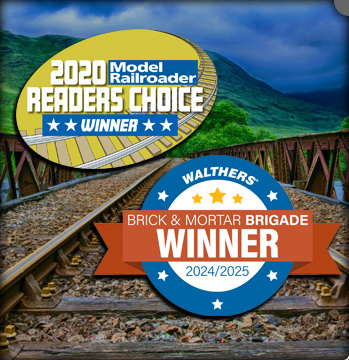ScaleTrains HO
ScaleTrains Rivet Counter HO SXT39199 DCC/ESU Loksound 5 Equipped EMD GP30 Locomotive Santa Fe 'Pinstripe - As Delivered' ATSF #1276
- In Stock:
- 2
- Scale:
- HO
- SKU:
- SXT39199
Description
Please note picture is representative of the item but may not be same road number. Always refer to product description for actual product details.
ScaleTrains Rivet Counter HO SXT39199 DCC/ESU Loksound 5 Equipped EMD GP30 Locomotive
Santa Fe 'Pinstripe - As Delivered' ATSF #1276

A new era continues with the Rivet Counter HO Scale EMD GP30. First introduced in 1961, the GP30 would become one of the most-common locomotives on the rails for the next two decades. Our Rivet Counter series model renders the numerous variations of cabs, dynamic brakes, doors, grilles, trucks, etc. Per the prototype and era, we’ve also incorporated LED lighting effects including front, rear, and side walkway lights; ground lights; printed and lighted number boards; and ditch lights.
Road Number Specific ScaleTrains
- New roadname
- Era: 1963 to early 1970s
- Series 1246 to 1284; built 1-6:1963
- Fully-assembled
- Multiple road numbers
- Operating LED-illuminated ground lights on both sides of locomotive*
- Operating LED-illuminated “hemisphere” walkway lights on hood ends, and at end of raised walkway duct*
- Operating LED-illuminated tricolor front and rear flush-mounted class lights with lenses and raised gaskets**
- Cab and rear number boards
- Front and rear multiple unit (MU) hose catch boxes and footboards
- 4-hose multiple unit (MU) hose clusters with silver gladhands
- Semi-scale coupler buffer equipped with durable metal semi-scale Type E knuckle couplers
- Front and rear straight uncoupling levers without loop handles
- As-delivered pilot faces without uncoupling lever loop notches
- Deck-mounted multiple unit (MU) receptacle
- “Short” stepwells with see-through steps
- Handrail set with center gangway chains
- Front and rear standard drop steps
- Scale sectioned treadplate detail with EMD early “X” style pattern
- 81” GP30 low short hood with ratchet handbrake and square sand fill
- Hinged battery box doors with early hinges and narrow louvers
- Early cab sub-base doors with early hinges
- Front standard EMD LED-illuminated headlight with lenses on number board housing
- GP30 cab with increased length on left (fireman’s) side and inverted cab heater vents
- Detailed cab interior with separate floor, rear wall, seats, and standard AAR control stand
- Cab side vent on left side
- Sliding cab side windows
- Small mirrors mounted fore of cab side windows on both sides of cab
- No sunshades or sunshade tracks
- Lost-wax brass cast Leslie Supertyfon S-2M over the cab engineers side and single chime S-25 over the cab conductors side
- Bendix-King 'can' style antenna mounted on cab roof
- Accurate hood door and long hood detail
- Late single-panel inertial compartment
- Wire inertial air intake grills
- Tall turbo exhaust stack
- Standard-range dynamic brakes with 48” fan
- Early See-through dynamic brake intake grills with horizontal wires through vertical vanes
- 7-horizontal rib radiator intake grills
- See-through front and rear 48” radiator fan housings with 8-blade fans; 36” pan-top center radiator fan
- Curved radiator fan grab iron
- Square sand fill hatch on top of long hood end
- Rear LED-illuminated horizontal headlight with lenses
- Underbody frame rail with separate plumbing
- Detailed Blomberg-B trucks with square and sloped bearing housings; elliptical springs; end transom detail; separate sanding lines and brackets; and separate swing hanger detail
- Dimensionally accurate truck centers
- Speed recorder mounted to second axle on right front truck sideframe
- Frame-mounted bronze bell
- No underbody air filter
- 2,600-gallon fuel tank with vertical gauges and fuel fill in sill skirt; round gauges in fuel tank sides
- Factory-applied wire grab irons, photoetched lift rings, windshield wipers, trainline hoses with silver gladhands, air tanks, sand hatch covers and more
- Motor with 5-pole skew wound armature
- Dual flywheels
- All-wheel drive
- All-wheel electrical pick-up
- Directional LED-illuminated headlights
- Printing and lettering legible even under magnification
- Operates on Code 70, 83 and 100 rail
- Packaging safely stores model
- Minimum radius: 18”
- Recommended radius: 22”
DCC & sound equipped locomotives also feature:
-
- ESU LokSound 5 DCC & Sound decoder with “Full Throttle”
- Two (2) cube-type speakers
- 16-cylinder 567D3 prime mover sound
- ESU designed “PowerPack” with two super capacitors***
- Operates on both DC and DCC layouts*****
DC/DCC & sound-ready locomotives also feature:
-
- Operable on DC layouts*****
- DCC-ready with 21-pin connector
* Lighting features operate when using an ESU decoder with appropriate programming while operating using DCC
** Class lights illuminate in white color only in DC operation. Access and changing colors requires an ESU decoder with appropriate programming while operating using DCC
***“PowerPack” feature only compatible with appropriately programmed ESU decoders operating on a DCC layout
*****Lombard Hobbies Recommendation - As modelers ourselves we highly recommend ONLY running DCC on DCC systems and DC on DC systems, regardless of 'Dual-Mode' capability. This gives optimum performance and safeguards the unit from possible damage from running on a different system than originally intended and from any inexperienced operator errors.
Prototype History:
The name "pinstripe" likely originates from the fine, elegant lines that adorned the locomotives, resembling subtle pinstripes on a suit. This design featured a predominantly gold-yellow body with a distinctive black pinstripe running along the sides of the locomotive, accentuating its streamlined contours. This new look became an iconic representation of Santa Fe's modern diesel fleet, symbolizing the railroad's commitment to both functionality and aesthetics.
Despite its official designation, the railroad staff in the Atchison office commonly referred to this paint scheme as "Yellow Noses," emphasizing the prominent yellow color on the locomotive's nose. This naming convention highlighted the visual impact of the gold-yellow color at the front of the locomotive, making it easily identifiable from a distance.
The pinstripe scheme remained a hallmark of the Santa Fe Railway's locomotives until 1972 when it underwent another transformation. Over the years, the "pinstripe" or "Yellow Noses" scheme became an enduring symbol of Santa Fe's diesel era, representing a blend of tradition and modernity on the rails.
By mid-1970, these GP30s were renumbered into the 3200-series. Approximately a decade later, after undergoing rebuilding and redesignation as GP30u, surviving units were incorporated into Santa Fe's 2700 class. Following the 1995 merger that formed BNSF, a significant portion of these units continued their service under the new railroad company, showcasing the enduring legacy of the Santa Fe Railway's EMD GP30s.
Lombard Hobbies - Your #1 Largest Authorized ScaleTrains Select Retailer!



































